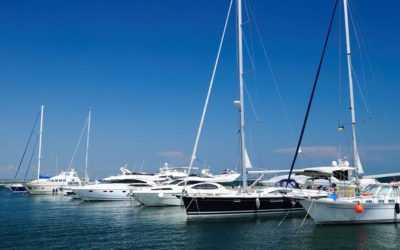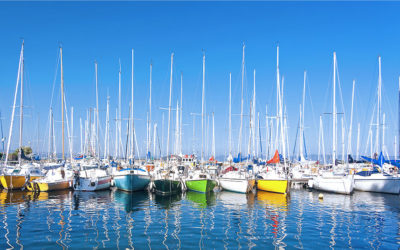The propeller is an important component that should be chosen carefully. The propeller design differs according to your navigation and your boat model. Band of Boats takes a closer look at this essential propulsion element for you.
1. What is the purpose of a marine propeller?
The propeller is the means of propulsion whose rotation is driven by the engine. The thrust created by the movement of the blades in the water generates the speed of the boat. The decisive factor in reaching the manufacturer-recommended speed is the propeller pitch. This is the distance travelled by the propeller to complete one full rotation about its axis.
2. What types of propeller are found on boats?
Propellers for OUTBOARD MOTORS are often made of an aluminium alloy. This has the advantage that the blades undergo little or no deflection when placed under load at high speed.
Propellers for INBOARD MOTORS are mainly made of bronze, mounted on a shaft.
The design also differs according to the type of boat: sailing boat or motor boat.
3. Propellers for sailing boats
A sailing boat generally uses a two-blade propeller, which considerably reduces drag when the boat is driven by sail only.
Certain racers use a folding “duckbill” prop. Up to 1 knot of speed can easily be gained in this way. It is important, however, to consider manoeuvres in port using the motor, because this propulsion system reacts more slowly.
That is why certain owners of large sailing boats prefer to equip their boats with a three-blade propeller. They prefer to have more manoeuvrability in the harbour to reach the landing stages and the mooring buoys and to sail under power in traffic, even though they lose speed when under sail.
4. Propellers for motor boats
Speedboats tend to use three-blade propellers. They are designed to achieve the best speed, acceleration, control, and durability.
Boats needing to sail slowly, such as recreational fishing boats and fishing boats, use propellers with four or five blades. Motor power at low engine speed is favoured: ideal for trolling, for example. Unfortunately, the speed does not exceed 10 to 12 knots.
For information, the propellers of certain submarines are equipped with more than six blades.
The large number of blades will better balance the propeller and reduce the effect of resonance.
You must therefore choose the appropriate propeller for your type of sailing.
The type of hull is also a selection criterion; the propeller must be adapted according to whether it is a planing or semi-floating hull.
Finally, the propeller should be chosen according to the engine power. It is mainly the engine manufacturers who recommend different types of propeller according to the engine power, type of hull, and sailing plans.
The Band of Boats favourite: BENETEAU FLYER 6 SPORTDECK
5. How to detect an inappropriate or badly positioned propeller?
Case 1: Impossible to reach the manufacturer speed rating at high engine speed, despite increased fuel inlet. CAUSE: The pitch is too great or the propulsive surface is too large. In other words, the resistive torque is too high.
Case 2: The engine tends to run too quickly when the combustion system is opened
(acceleration example) and when the speed is too low. CAUSE: The propeller pitch is too low or the hull surface is too small.
A few adjustment tips:
For an outboard motor, there is a risk of cavitation if the engine adjustment shim is positioned too high.
Conversely, there is a risk of splash when the height adjustment shim is positioned too low.
The propeller must be submerged as deep as possible to reduce the risk of cavitation.
Band of Boats invites you to consult propeller manufacturers. With their calculation software, they will be able to make and replace any type of propeller.
Dealers can also help you with your purchase. Do not hesitate to ask them.

